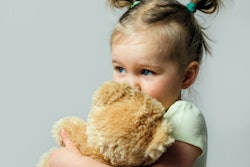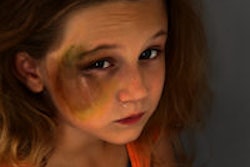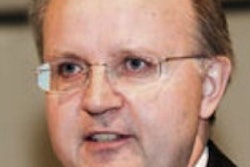
Fresh data about suspected cases of abuse show that about a quarter of children evaluated at an inner city hospital by means of a skeletal survey with radiography were found to be the victims of abuse. Furthermore, of the abused children, around 39% had skeletal trauma and 61% did not.
The most commonly encountered fracture was parietal skull fracture, which was rarely associated with abuse (1 of 15 cases positive for abuse). The next most common fracture was femoral diaphyseal fracture, which was associated with abuse 50% of the time, according to Dr. Heather Imsande, a final-year radiology resident at Boston University School of Medicine in the U.S., and colleagues.
"Many children seen at our hospital for osseous injury arrive with parents or caregivers with concurrent psychiatric or drug-related problems. In addition, these children may have multiple caregivers, even underage relatives, and the time or location of the sustained injury may be unknown," they pointed out in an ECR 2015 e-poster. "Our patient population is at risk for both accidental and nonaccidental trauma, and appropriate evaluation and home visits are necessary to provide a safe environment for the child."
The authors' institution is a "safety-net" hospital, which predominantly treats the underserved. Between January 2011 and December 2013, 81 skeletal surveys were performed on 67 children with suspected abuse.
"Stakes are high in this group, and an inappropriately low level of clinical suspicion, a misinterpreted radiograph, or inadequate family evaluation and follow-up can be fatal for the patient," they noted. "Appropriate multidisciplinary evaluation for abuse can save a child's life."
When a skeletal survey is ordered, the technologist/radiographer and radiologist must adhere to the skeletal survey protocol as recommended by the American College of Radiology (ACR) or similar organization, so as to image the osseous structures with adequate detail. The radiologist should guide further imaging with additional radiographs, other imaging modalities, and follow-up studies. In addition to identifying fractures, the radiologist often will need to classify normal and variant anatomy, Imsande and colleagues recommended.
When a child presents with suspicious signs or symptoms, the emergency physician or pediatrician orders a skeletal survey. In some cases, the child has a known fracture based on dedicated radiographs of that particular bone, and in other cases the child may present with another injury such as a bruise or burn, or with failure to thrive.
Skeletal survey protocol for suspected child abuse used in Boston
Appendicular skeleton
- Right and left humerus anteroposterior (AP) only
- Right and left forearm AP only
- Right and left hand AP only
- Right and left femur AP only *
- Right and left tib/fib AP only
- Right and left foot AP only **
Axial skeleton
- AP chest
- Both obliques of the chest
- AP abdomen ***
- Lateral cervical spine
- Lateral thoracic spine
- Lateral lumbar spine ****
- AP and both laterals of skull
Additional views if needed
- Lateral views of selected joints
* Femurs can be performed together if patient is 12 months old or younger.
** Feet can be performed separately or together, no age discrepancy.
*** AP chest and abdomen can be done as a "babygram" only if patient is 12 months old or younger.
**** Lateral T and L spine can be done together if patient is 12 months old or younger.
Source: Dr. Heather Imsande, Boston University School of Medicine, presented at ECR 2015.
After the radiographs are acquired, the technologist/radiographer checks them with the radiology resident and/or attending while the child remains in the radiology department. If the patient has suspected head or spinal trauma, CT or MRI is performed. If the patient has suspected intrathoracic or intra-abdominal trauma, a dedicated ultrasound or CT is performed. CT scans are performed using the hospital's trauma protocols, which all include intravenous contrast unless there is a contraindication such as allergy or renal failure, they explained.
For penetrating trauma, oral and rectal contrast are administered. All trauma CT scans are checked by the radiologist after the initial scan while the patient remains on the CT table, and delayed images are acquired on a case-by-case basis.
In cases of suspected child abuse, the primary physician is mandated by law to consult the U.S. Department of Children and Families (DCF). An individual from DCF is assigned to each case, and an investigation is performed. Observations and diagnoses made by the primary physician, as well as laboratory and radiologic results, are used in the investigation. The DCF representative usually visits the patient's home or the suspected site of abuse, and ultimately determines whether each incident was abuse-related.
Of the 67 children with suspected abuse, 32 (47.8%) had radiographic evidence of at least one skeletal injury, including fractures and periosteal reaction. After evaluation by the primary physician and DCF, 18 of the 67 children (26.9%) with suspected abuse were deemed to have been victims of physical abuse. Seven of these patients had skeletal trauma on their skeletal survey, and 11 did not. Therefore, of the 32 cases of skeletal trauma as seen on skeletal surveys, seven were from abuse (21.9%) and 25 were accidental (78.1%).
Seven patients had more than one osseous injury: five were confirmed cases of abuse, one was accidental, and one was a patient with osteogenesis imperfecta with suspicious femur and rib fractures who was lost to follow-up. All metaphyseal corner fractures were from abuse (n = 6). In 16 of the 18 cases of child abuse, one or both parents were the abusers, and custody of the child was taken from the parent(s) in 13 instances. One child was abused at a daycare facility, and the other at the father's family home.
At the Boston hospital, the pediatric radiologist is on site and available to read skeletal surveys between Monday and Friday from 8 a.m. to 5 p.m. For pediatric studies performed overnight and on the weekend, the on-call radiology resident issues a preliminary report, and the pediatric radiologist is available by page to the resident on call. Of the 81 skeletal surveys performed between 2011 and 2013, 21 were carried out at night or over the weekend and were, therefore, preliminarily read by the resident. Although the attending physician can view the images by request and will later review them, it is important for the resident to be familiar with the above-mentioned intricacies of the skeletal survey, according to the authors.
Skeletal trauma is common in child abuse, and initial skeletal surveys are standard of care in the evaluation of abuse in children younger than 24 months of age, they continued. Skeletal surveys have been shown to reveal new information in about 11% to 23% of all children evaluated for possible physical abuse. A follow-up skeletal survey is recommended about two weeks after the initial survey if abnormal or equivocal findings are present on the initial radiographs, and when there is clinical suspicion of abuse. The follow-up survey has been shown to identify occult fractures present at the time of the initial evaluation after callus has formed and to clarify equivocal findings on the initial study.
Fractures with high specificity for child abuse are classic metaphyseal corner fractures, multiple rib fractures (especially posterior), and sternal, clavicular, and spinous process fractures, Imsande and colleagues wrote. Fractures with moderate specificity are multiple fractures, including fractures in various stages of healing, epiphyseal separations, vertebral body fractures and separations, digital fractures, and complex skull fractures. Osseous injuries with low specificity for abuse include subperiosteal new bone formation, clavicular fractures, long-bone shaft fractures, and linear skull fractures.
"Normal structures and variants can mimic injuries sustained from abuse, and the radiologist must be aware of the imaging appearances of normally developing bones," they noted. "For example, Wormian bones and cranial sutures can be mistaken for abusive injury, as can ossification centers, vertebral body wedging, pseudosubluxation, and nutrient canals within the spine. Within the appendicular skeleton, physiologic periosteal reaction, metaphyseal step-off, metaphyseal beak, metaphyseal spur, metaphyseal fragmentation, distal ulna metaphyseal cupping, proximal tibial cortical irregularity, and nutrient vessels can mimic abuse."
Ultrasound, CT, and MRI can be considered in the evaluation for child abuse, especially if radiographs are equivocal, added the authors. MRI can be useful in classifying brain trauma and in identifying cervical spine injury, while 3D CT reformats also improve detection of skull fractures and accessory sutures. Low-dose chest CT can be performed with a dose of 0.56 mSv, which is less than twice that of a four-view chest radiograph (0.29 mSv), and can identify previously unseen fractures of the ribs, scapula, and vertebral bodies in cases of suspected child abuse.

















